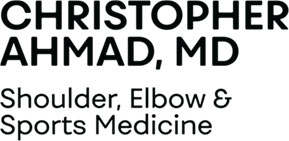When I meet a player in the recovery room to give the news on how his Tommy John Surgery went, I often get an immediate question – “Doc, how many strands did you get?”
Tommy John surgery begins with an incision over the inside aspect of the elbow, and continues with a dissection that is carried through tissues until the UCL is fully exposed. Once the UCL tear is confirmed, reconstruction is carried out. This phase begins with drilling tunnels at the precise locations on the bone where the UCL naturally attaches.(Figure 1) Once the bone tunnels are created and connected, the graft is usually obtained from the wrist’s tendon, known as the palmaris longus. A fun fact to note here, is that twenty percent of people do not have a palmaris longus at their wrist and, removal of this tendon will not influence the ability to return to throwing.
Patients who have either a very small palmaris longus, or don’t have one at all, typically have the graft taken from their knee. In order to determine if the palmaris longus tendon is too small, I compare the athlete’s palmaris to my own. If theirs is smaller than mine, than it is too small. Once the graft is obtained and cleaned, the free end has high-strength sutures placed in it. Next, the graft is woven through the bone tunnels, and secured in place with sutures.
This grafting procedure was first developed by Dr. Jobe, and entails weaving the graft through the tunnels back and forth for a total of 3 strands. Other surgeons have modified the technique to make it an easier surgery to perform, and use only 2 strands. (Figure 1) I always attempt to get as many strands of the palmaris as possible.
Figure 2 shows a typical UCL tear in a high level pitcher. Figure 3 shows 2 strands placed as indicated with the blue arrows. The yellow arrow indicates the extra graft that can be used to add additional strength to the reconstructed ligament. Figure 4 shows the extra graft woven through the tunnels with the yellow arrow indicating the 4th strand just before it is secured. This creates a larger ligament, which, in theory, will be more durable.
No matter how many times, when after a surgery I meet the player in the recovery room, and they ask that familiar question, I’m happy to explain that 4 strands were used, and to get a strong smile in return.





